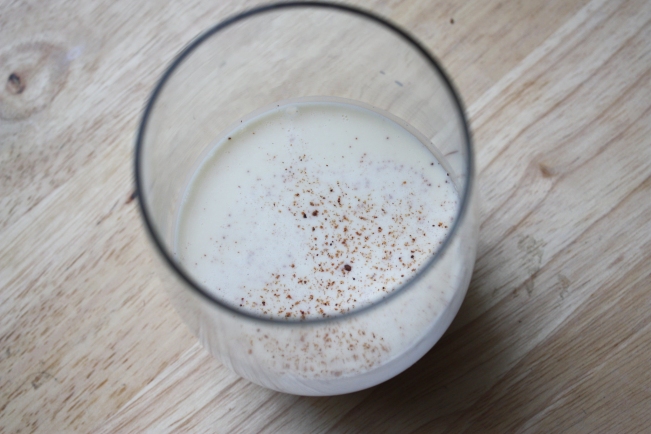Have you and/or your family had a cup this season?!
Monica Corrado of Simply Being Well offered this simple recipe on her former blog: “raw milk and raw egg yolks; often 5 yolks to about 8-12 oz. of milk. Stir. Down the hatch! I was a disbeliever-and then I tried a glass.” Monica writes, “I do not encourage you to try this with pasteurized milk or cream. Organic or not, from grass-fed cows or not, pasteurized milk is hard to digest for most people and is just not worth it. A possible compromise: use watered down organic, whole milk, plain yogurt with pastured egg yolks. Just “up” the number of yolks and add vanilla and a bit of maple syrup to counter the sour yogurt taste!”
Other nutrient dense recipes:
Basic Eggnog from the Traditional Cooking School
Holiday Eggnog and Eggnog Ice Cream by Passionate Homemaking
Eggnog Recipe from Nourishing Traditions. Note that this recipe includes a variation: coconut milk as an alternative to milk for those who seek a diary free option!
A bit of history
The reason you won’t find 16th century recipes for “egg nog” is the term didn’t appear in print until the next century. Food historians/period recipes confirm English recipes for posset (esp. sack posset) were very similar to later egg nog. References to 16th century Jamestown egg nog were published after the from 18th century forwards, it is most likely the author was using a newer/more popular and accepted American term to denote an old traditional English holiday beverage.
How old is egg nog? (name in print, not the recipe)
“By the mid-1760s patrons were drinking eggnog, juleps, sling and sanger in addition to the punch and toddy already available.” – “Taverns and Tavern Culture in the Southern Colonial Frontier: Rowan County, North Carolina, 1753-1776,” Daniel B. Thorpe, Journal of Southern History, Vol 4, no. 2, November 1996 (p. 686)
“Rich and creamy dessert drinks, such as eggnog and syllabub, reflect the English heritage in America, especially in the South. In England posset was a hot drink in which the white and yolk of eggs were whipped with ale, cider, or wine. Americans adapted English recipes to produce a variety of milk-based drinks that combined rum, brandy, or whiskey with cream. The first written reference to eggnog was an account of a February 1796 breakfast at the City Tavern in Philadelphia. Beginning in 1839 American cookbooks included recipes for cold eggnogs of cream, sugar, and eggs combined with brandy, rum, bourbon, or sherry, sprinkled with nutmeg. Southerners enjoyed a mix of peach brandy, rum, and whiskey.” – Oxford Encyclopedia of Food and Drink in America, Andrew F. Smith [Oxford University Press:New York] 2004, volume 2 (p. 423)
The earliest reference to eggnog cited in the Oxford English Dictionary [2nd edition, London] is from 1825. The beverage is defined as “A drink in which the white and yolk of eggs are stirred up with hot beer, wine, or spirits.”
What is posset?
“Possets were all the rage in the later Middle Ages, and survived unto the nineteenth century, but are no longer heard of. They were a warming concoction of hot milk mixed with hot beer, sherry, etc., sugar, and various spices, excellent for keeping the cold at bay in the days before central heating, and no doubt effective as a nightcap too. The source of the word is is not known, although some have suggested a link with Latin posca, a term for a drink made from vinegar and water.” – A-Z of Food & Drink, John Ayto [Oxford University Press:Oxford] 2002 (p. 266)
Read more about the history of this holiday tradition and see our discussion on this Facebook post.
Photo credit: Jeffrey Morganthaler.

8 Responses to Nutrient Dense Egg Nog
I love love eggnog. Last year I made some for the very first time, but with real fresh ground nutmeg and vanilla bean specks. DELICIOUS!!!
I love that many store bought versions of food items such as egg nog can be made at home with relative ease and be much more nutritious and delicious!
I raised my kids on a similar drink I call a smoothie. Milk and raw eggs in a blender, usually with banana and berries. This is still a daily staple for me.
My current version is made from raw local milk that is made into a sweet yogurt drink by adding previous made yogurt to a gallon of milk and leaving for 24 hours at room temperature. The bacteria multiply profusely but only to the point of slightly tangy. The milk is still sweet and not thick. Yet it still has all the probiotic benefits.
Add a couple of pasture produced whole eggs, some organic banana – raspberries – strawberries – blackberries and/or blueberries into a personal blender and you have the ultimate nutritious fast food.
This is great any time day or night. Egg nog is mentioned in the “Little House on the Prairie” books. She described how a person could easily work extremely hard all day making hay with only egg nog for sustenance.
Your yogurt drink is brilliant….no worrying about incubating at the right temp. Never thought of doing it this way…I am going to try this next time instead of incubating my yogurt in a cooler.
[…] Quiche with Gluten-Free Almond Flour Crust • Shakshukah: Edible Mediterranean Sunshine • Nutrient Dense Egg Nog – with lots of fun nerdy […]
The link to for the nourishing traditions recipe is no longer working.
The blog that published the recipe is not longer up. I recommend you purchase the book!
It is such a worthwhile book to have! Meanwhile, I did a search online and found it published elsewhere: https://www.copymethat.com/r/PesywnU/eggnog-recipe-from-nourishing-traditions/